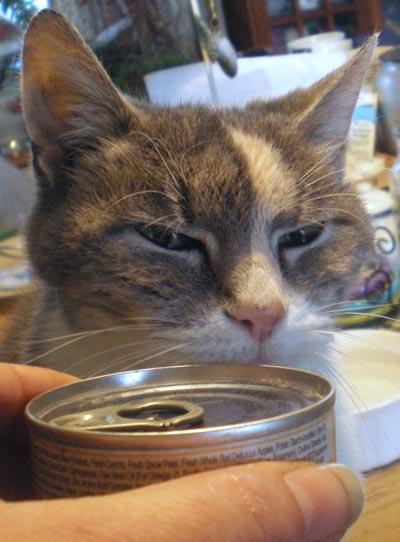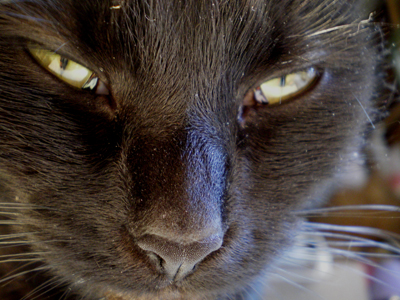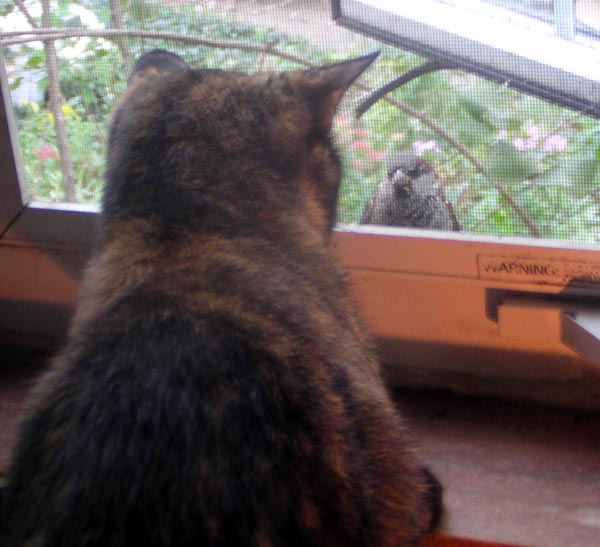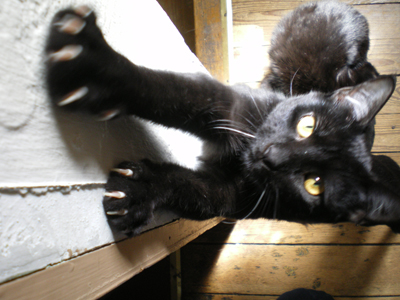 A healthy cat will eat what you give her, a kitty who is a little under the weather may need some persuasion; we won’t be talking about those manipulative and overly dramatic “finicky” kitties here. We’re considering cats who are recovering from illness or injury or who are elderly, and for whom even eating is a little bit of a burden. She may seem hungry, even show up for mealtime, but take a sniff or even attempt to eat and walk away. Often illness, surgery, trauma or age reduce a cat’s appetite through weakness, stomach upset, loss of smell or loss of taste, and a cat in a slightly weakened condition may need some inspiration for the taste buds. First, wake her up at least 15 minutes before you want to feed her—a sleepy kitty in a weakened condition isn’t ready to eat as soon as she wakes up, so pet her and give her attention for a while until she seems entirely alert. Always use fresh food, usually canned, so its smell is the strongest, and you don’t need to resort to fish-based foods, often liver-based food is more appealing. Then tease her with the food—play “kitty airplane” the same way you would with a recalcitrant child, show her the can and her dish, open the can and let kitty sniff the food then put it aside, making a big show of getting her dish ready, putting the food in the dish, allowing her to smell it all the while, then finally present it. This little play helps to get her digestive system started and her body gives her the signal to eat, plus, she’s wondering what they heck you’re up to, and curiosity is a big stimulant for a cat. If she’s still reluctant, pick up a little in a spoon and offer it for her to lick off; a little at a time is sometimes just enough. Don’t leave her food out, but put it back in the can and keep it, offering it again a little later. It may mean wasting a few cans, but open a new can with every session. She’ll appreciate your efforts.
A healthy cat will eat what you give her, a kitty who is a little under the weather may need some persuasion; we won’t be talking about those manipulative and overly dramatic “finicky” kitties here. We’re considering cats who are recovering from illness or injury or who are elderly, and for whom even eating is a little bit of a burden. She may seem hungry, even show up for mealtime, but take a sniff or even attempt to eat and walk away. Often illness, surgery, trauma or age reduce a cat’s appetite through weakness, stomach upset, loss of smell or loss of taste, and a cat in a slightly weakened condition may need some inspiration for the taste buds. First, wake her up at least 15 minutes before you want to feed her—a sleepy kitty in a weakened condition isn’t ready to eat as soon as she wakes up, so pet her and give her attention for a while until she seems entirely alert. Always use fresh food, usually canned, so its smell is the strongest, and you don’t need to resort to fish-based foods, often liver-based food is more appealing. Then tease her with the food—play “kitty airplane” the same way you would with a recalcitrant child, show her the can and her dish, open the can and let kitty sniff the food then put it aside, making a big show of getting her dish ready, putting the food in the dish, allowing her to smell it all the while, then finally present it. This little play helps to get her digestive system started and her body gives her the signal to eat, plus, she’s wondering what they heck you’re up to, and curiosity is a big stimulant for a cat. If she’s still reluctant, pick up a little in a spoon and offer it for her to lick off; a little at a time is sometimes just enough. Don’t leave her food out, but put it back in the can and keep it, offering it again a little later. It may mean wasting a few cans, but open a new can with every session. She’ll appreciate your efforts.


 A healthy cat will eat what you give her, a kitty who is a little under the weather may need some persuasion; we won’t be talking about those manipulative and overly dramatic “finicky” kitties here. We’re considering cats who are recovering from illness or injury or who are elderly, and for whom even eating is a little bit of a burden. She may seem hungry, even show up for mealtime, but take a sniff or even attempt to eat and walk away. Often illness, surgery, trauma or age reduce a cat’s appetite through weakness, stomach upset, loss of smell or loss of taste, and a cat in a slightly weakened condition may need some inspiration for the taste buds. First, wake her up at least 15 minutes before you want to feed her—a sleepy kitty in a weakened condition isn’t ready to eat as soon as she wakes up, so pet her and give her attention for a while until she seems entirely alert. Always use fresh food, usually canned, so its smell is the strongest, and you don’t need to resort to fish-based foods, often liver-based food is more appealing. Then tease her with the food—play “kitty airplane” the same way you would with a recalcitrant child, show her the can and her dish, open the can and let kitty sniff the food then put it aside, making a big show of getting her dish ready, putting the food in the dish, allowing her to smell it all the while, then finally present it. This little play helps to get her digestive system started and her body gives her the signal to eat, plus, she’s wondering what they heck you’re up to, and curiosity is a big stimulant for a cat. If she’s still reluctant, pick up a little in a spoon and offer it for her to lick off; a little at a time is sometimes just enough. Don’t leave her food out, but put it back in the can and keep it, offering it again a little later. It may mean wasting a few cans, but open a new can with every session. She’ll appreciate your efforts.
A healthy cat will eat what you give her, a kitty who is a little under the weather may need some persuasion; we won’t be talking about those manipulative and overly dramatic “finicky” kitties here. We’re considering cats who are recovering from illness or injury or who are elderly, and for whom even eating is a little bit of a burden. She may seem hungry, even show up for mealtime, but take a sniff or even attempt to eat and walk away. Often illness, surgery, trauma or age reduce a cat’s appetite through weakness, stomach upset, loss of smell or loss of taste, and a cat in a slightly weakened condition may need some inspiration for the taste buds. First, wake her up at least 15 minutes before you want to feed her—a sleepy kitty in a weakened condition isn’t ready to eat as soon as she wakes up, so pet her and give her attention for a while until she seems entirely alert. Always use fresh food, usually canned, so its smell is the strongest, and you don’t need to resort to fish-based foods, often liver-based food is more appealing. Then tease her with the food—play “kitty airplane” the same way you would with a recalcitrant child, show her the can and her dish, open the can and let kitty sniff the food then put it aside, making a big show of getting her dish ready, putting the food in the dish, allowing her to smell it all the while, then finally present it. This little play helps to get her digestive system started and her body gives her the signal to eat, plus, she’s wondering what they heck you’re up to, and curiosity is a big stimulant for a cat. If she’s still reluctant, pick up a little in a spoon and offer it for her to lick off; a little at a time is sometimes just enough. Don’t leave her food out, but put it back in the can and keep it, offering it again a little later. It may mean wasting a few cans, but open a new can with every session. She’ll appreciate your efforts.